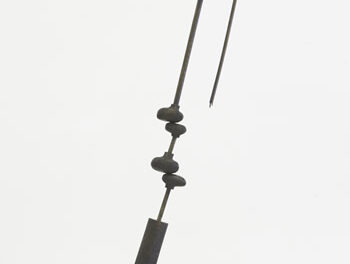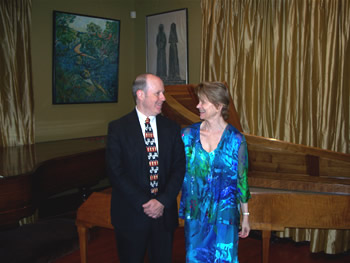Asheville has long been nicknamed “The Paris of the South,” for its vibrant arts scene. This extends beyond the professional organizations into the wider community aesthetic, with numerous civic ensembles of amateur and professional musicians creating art of the highest caliber, simply for the sake of doing so. The Blue Ridge Orchestra has maintained a successful presence in the Western NC community since 1999. This success requires more than an ensemble of dedicated musicians. There are two additional components necessary for a community orchestra to thrive, and Asheville is fortunate to have both: the conductor – Milton Crotts – and the audience. The latter was apparent on the opening night performance of the March concert, with the multitude of pews in the Grace Baptist Church of West Asheville filled to capacity. It was encouraging to see so much support for the music of Bach, Haydn, and Beethoven in a small city already boasting a professional orchestra and several chamber groups. While not at the level of Asheville Symphony or other surrounding symphony orchestras, Blue Ridge Orchestra certainly held its own as a civic ensemble of the highest order, especially considering that 75 of the organization’s members are volunteers.
The orchestra got off to a shaky start in three movements from Bach’s Suite No. 2 for Flute and String Orchestra. The intonation in the violins was uneven in the Polonaise, and the continuo part in the cello section was played with a stilted and overtly mechanical aggressiveness in the Menuet. Featured soloist Judi Lampert, however, stood out with a captivating performance in all three of the selected movements. This was especially apparent in the final selection of the Badinerie. Lampert performed the spritely number with a rich and full tone, commanding a powerful sound even in the lowest register of her instrument. Her sound soared beautifully over the orchestra, maintaining relaxed precision as she fluidly navigated Bach’s cascading sequences. The following selection was the “Nocturne” from Fauré’s Shylock, with Lampert fulfilling the role of first violin on her flute. This reviewer, initially skeptical of the alteration in orchestration, was pleasantly surprised by how effectively the solo flute balanced against the entire string ensemble. Crotts did an impeccable job maintaining the subtle changes in texture and dynamic contrast between the soloist and orchestra, all exclusively with his right hand. (A few weeks ago, Crotts injured his left hand, but this did not deter him from communicating the musical nuances of the Fauré with superb command.)
Crotts continued to demonstrate his mettle as the leader of the Blue Ridge Orchestra when introducing Lampert’s encore performance of Debussy’s solo flute classic “Syrinx.” For a community ensemble leader to be successful he/she must possess more than musical expertise and conducting acumen: he/she must enjoy and effectively engage with the general public. Crott’s introduction of the mythological tale inspiring “Syrinx” was infused with practical enthusiasm, his conversational and amiable style engaging and educating the audience. Lampert once again shone; her interpretation of Debussy’s meandering melodic fragments were executed with a beautiful timbre. The undulating pentatonic and whole-tone passages in the middle section were performed with marvelous dynamic contrast, and the final whole-tone figure gently descended to a beautifully controlled whisper.
The first half concluded with Haydn’s Symphony No. 6 (Le Matins), aptly titled for its famous introductory “sunrise” motive. The intonation problems in the Bach were now remediated, with the first violins’ harmonization of the theme a third above the second violins’ answer radiating with a glowing radiance that transformed the visual beauty of sunrise into an aural treat. The wind consort within the orchestra especially shone (pun intended) in this first movement, the alternating sixteenth-note passages traded among the flute, oboes, and bassoon with immaculate dynamic balance. The second movement experienced some balance issues with the double bass overpowering the rest of the ensemble at times, but Crotts quickly adjusted the problem with relaxed poise and subtle cues. The Menuet of the third movement was a delight to hear, the horn and bassoon fusing seamlessly into a sumptuous timbre. Lampert had an opportunity to shine once more as her brief flute interlude before the closing chords exuded a warm brilliance. In the finale, various sections of the orchestra were afforded their own opportunities to shine. Lampert’s rapid scalar runs were executed with rhythmic precision, the violins performed with a tender synchronicity, and the gently descending duet between the two oboes was performed with excellent intonation.
The true gem of the evening, however, was the ensemble’s performance of Beethoven’s Symphony No. 1. The Adagio got off to a shaky start but magnificently coalesced into a single unit of sound by the Allegro. Oboist Pat Stone and Lampert beautifully exchanged the B theme with elegance, and the augmented double bass section executed the transition back in to the A theme with sublimely coordinated energy. The balance overall was fantastic, the brass and winds never overpowering the strings. Timpanist David Fox should be especially commended for his judicious attention to Beethoven’s dynamics. In the Beethoven symphonies, the timpanist is truly the assistant conductor, and Fox set the tone for the entire orchestra with his precise articulations and command of the instrument’s coloristic capabilities. The wind section shone once again in the Menuetto, the clarinets and horns amalgamating into a sweet and warm timbre. The rapid tempo of this movement did not deter the orchestra as the musicians performed the jocund melody with fervid gusto. The fourth movement began with a reluctant opening, with the exposed introduction in the first violins played with timid caution. This initial hesitancy, however, was immediately contrasted with a stellar interpretation of the skyrocketing sixteenth-note entrance into the A theme. The heroic melodic interchange between the winds and strings surged with glorious energy, showcasing the passion of this community ensemble. This was the ensemble’s strongest performance of the evening, with each section balanced exquisitely under Crott’s astute baton. Indeed, this final number proved how fortunate Asheville is to have Crotts as a musical leader. His musical expertise and commitment to outreach in the community continue to elevate the city’s reputation as a destination for the arts.












